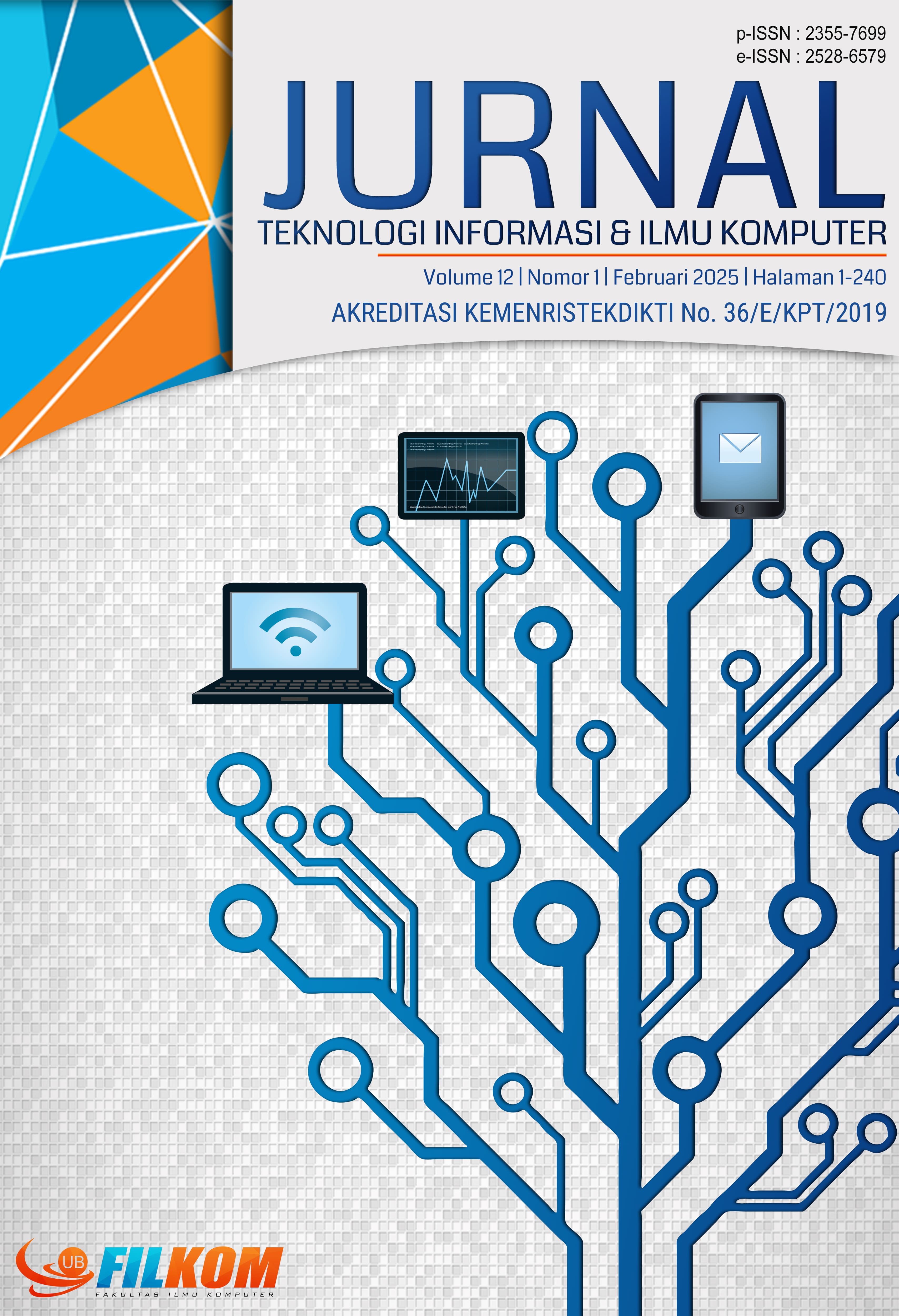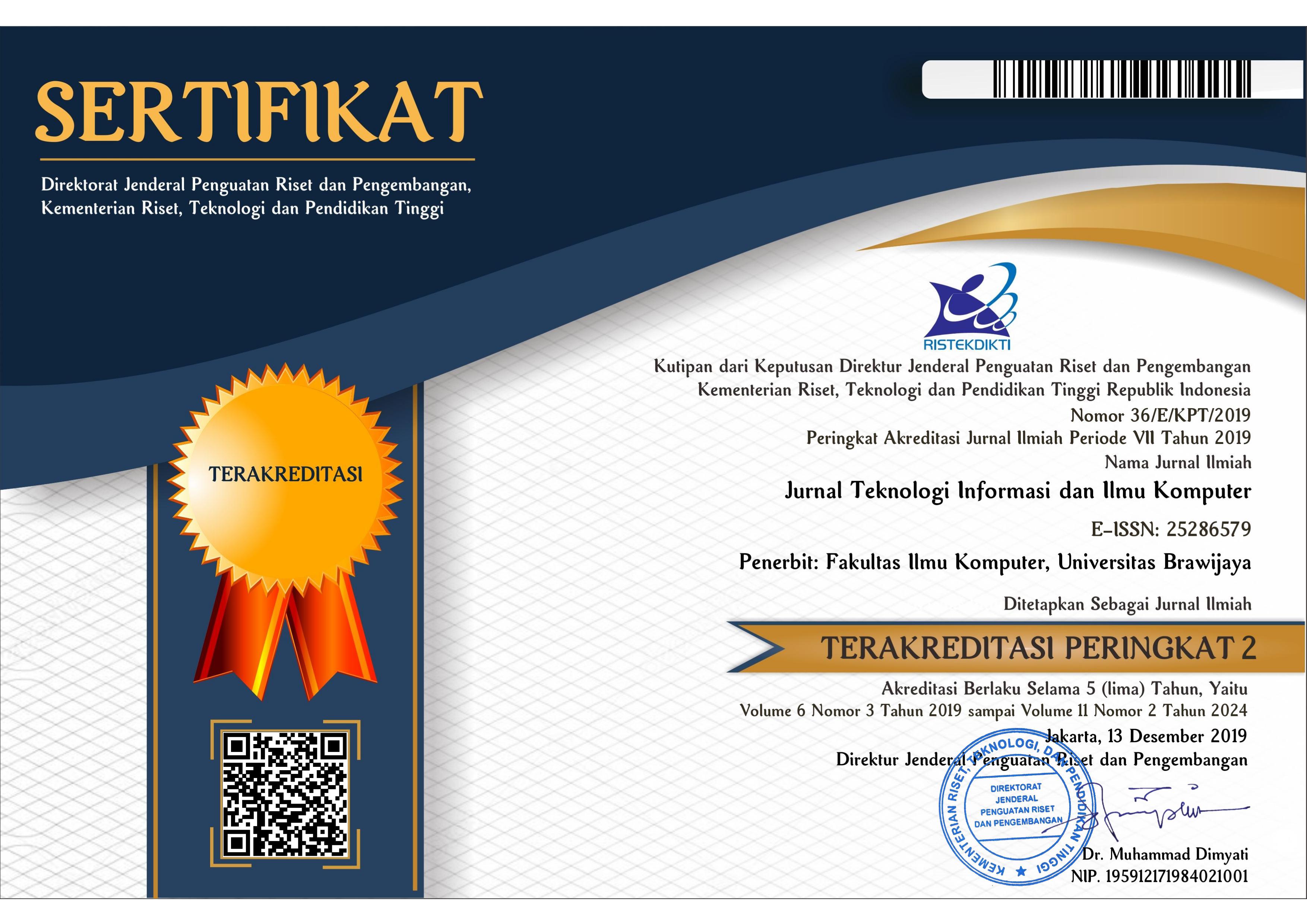Sistem Monitoring Terpadu untuk Kelompok Geriatri Menggunakan Fuzzy Mamdani Dan Deep Learning
DOI:
https://doi.org/10.25126/jtiik.2025128717Kata Kunci:
sistem monitoring, geriatri, deep learning, fuzzy mamdaniAbstrak
Geriatri merupakan salah satu kelompok rentan yang membutuhkan monitoring yang intensif untuk meningkatkan kualitas hidup dari kelompok geriatri itu sendiri. Implementasi kecerdasan buatan (AI) memberikan kemudahan bagi pengguna maupun kelompok geriatri. Di dalam penelitian ini dibangun sistem monitoring bagi kelompok geriatri berbasis parameter saturasi oksigen, detak jantung dalam satuan (beats per minute) (BPM) dan temperatur tubuh yang bertujuan untuk memudahkan dalam memonitoring geriatri melalui teknologi AI. Perangkat menggunakan sensor MAX30205 dan sensor MAX30102 yang diintegrasikan dengan mikrokontroler ESP32 sehingga dapat memonitor kondisi geriatri secara real-time. Implementasi pemodelan untuk mendeteksi kondisi geriatri apakah stabil atau tidak stabil menggunakan deep learning (DL) yang dikembangkan berbasis aturan fuzzy mamdani. Terdapat 10 model DL yang dikomparasi dengan arsitektur layer dan epoch yang berbeda, di mana menghasilkan akurasi tertinggi pada model 8 dengan persentasi akurasi 97,8% dan F1-score sebesar 0,98. Pengujian dilakukan dengan mengukur sensitifitas sistem terhadap pembacaan tiga parameter pada kelompok geriatri, di mana menghasilkan nilai MAPE sebesar 1,33% dan akurasi 98,67%. Sementara pengujian persepsi sistem melalui pemodelan DL yang terintegrasi dengan fuzzy mamdani terhadap data riil pada tiga parameter dilakukan dengan melibatkan 15 partisipan. Berdasarkan eksperimen tersebut, dihasilkan 14 pengujian yang menghasilkan data yang sesuai antara nilai aktual dan nilai hasil. Sehingga akurasi persepsi sistem terhadap kondisi stabilitas kelompok geriatri adalah 93,33%. Penelitian ini berkontribusi dalam meningkatkan kualitas hidup kelompok geriatri melalui implementasi monitoring yang terintegrasi dengan AI serta memiliki originalitas di mana sistem yang dibangun mengkombinasikan teknologi DL dengan teknik Fuzzy untuk menghasilkan akurasi data yang optimal.
Abstract
Geriatrics represents one of the vulnerable communities that requires intensive monitoring to enhance the quality of life within the geriatric itself. The implementation of artificial intelligence (AI) provides convenience for both users and the geriatric population. In this study, a monitoring system based on oxygen saturation parameters, heart rate in beats per minute (BPM), and body temperature was developed for the geriatric and aims to monitor the geriatric by utilizing AI technology. The device utilizes MAX30205 and MAX30102 sensors integrated with the ESP32 microcontroller to monitor the geriatric condition in real-time. The implementation of modeling to detect whether the geriatric condition is stable or unstable uses deep learning (DL) developed based on Fuzzy Mamdani rules. There are 10 DL models compared with different layer architectures and epochs, resulting in the highest accuracy in model 8 with an accuracy rate of 97.8% and an F1-score of 0.98. Testing was conducted by measuring the system's sensitivity to readings of three parameters in the geriatric group, yielding a Mean Absolute Percentage Error (MAPE) value of 1.33% and an accuracy of 98.67%. Meanwhile, the perception testing of the system through DL modeling on real data for three parameters involved 15 participants. Based on these experiments, 14 tests were conducted, producing data consistent between actual and observed values. Thus, the system's accuracy in perceiving the stability of the geriatric group's condition is 93.33%. This study contributes to improving the quality of life of geriatric groups through implementing monitoring integrated with AI and has originality where the system combines DL technology with fuzzy techniques to gain optimal data accuracy.
Downloads
Referensi
AIDIL., SUGIONO, P.S., PUTRA, A.S. 2022. Pembentukan Aturan Fuzzy Untuk Pemberian Rekomendasi Penerima Bantuan Keluarga Berumah Tidak Layak Huni Menggunakan K-means Clustering. INSYST: Journal of Intelligent System and Computation, 4(2), pp. 82-95.
AKHILA, L., MEGHA, B. S., NIKHILA, M. S., SREELAKSHMI, B., VYKHA, P., ANU, C., SREEHARI, K.N. 2021. IoT- enabled Geriatric Health Monitoring System. Proceedings of the Second International Conference on Electronics and Sustainable Communication Systems, pp. 803-810.
BADRIYAH, T., SANTOSO, D. B., SYARIF, I., SYARIF, D. R., 2019. Improving stroke diagnosis accuracy using hyperparameter optimized deep learning. International Journal of Advances in Intelligent Informatics, 5(3), pp.256-272.
BPS, 2022. Statistik penduduk lanjut usia 2022. Jakarta: Badan Pusat Statistik.
ELFALADONNA, F. & ISA, I. G. T., 2022. Uji Efektifitas Metode Fuzzy Logic Mamdani pada Penerimaan Beasiswa Bantuan Menggunakan Matlab. Sintech Journal, 5(1), pp. 75-46.
HOU, Y. E., GU, W., DONG, W., DANG, L., 2023. A deep reinforcement learning real-time recommendation model based on long and short-term preference. International Journal of Computational Intelligence System, 16(4), pp. 1-14.
HSIAO, S-. J., SUNG, W-. T., 2023. Intelligent home using fuzzy control based on AIoT. Computer System Science & Engineering, 45(2), pp. 1063-1082. https://doi.org/10.32604/csse.2023.028438
LIOTTA, G. LORUSSO, G., MADARO, O., FORMOSA, V., GIALLORETI, L. E., DONNOLI, C., …, PALOMBI, L., 2023. Exploratory Factor Analysis of the Short Functional Geriatric Evaluation (SFGE) to Asses the
Multidimensionality of Frailty in Community-Dwelling Older Adults. International Journal of Environmental Research and Pub. Health, 20(4129), pp.1-9.
MINARNO, A. E., MANDIRI, M. H. C., ALFARIZY, M. R., 2021. Klasifikasi COVID-19 menggunakan filter gabor dan CNN dengan hyperparameter tuning. ELKOMIKA, 9(3), pp. 493-504.
MORITA, P. P., SAHU, K. S. & OETOMO, A., 2023. Health Monitoring Using Smart Home Technologies: Scoping Review. JMIR MHealth and Uhealth, 11(e37347), pp. 1-15.
MUNTAHANAH, HANDAYANI, S. & LIDIA, 2021.
Penerapan Metode Fuzzy Mamdani Penentuan Strategi Belajar Siswa Pada Persiapan Ujian Nasional Berbasis Komputer (UNBK). Jurnal Pseudocode, 8(2), pp. 108-117.
MUZARAFAH & MARLINA, 2022. Penerapan Metode Fuzzy Mamdani Dalam Diagnosa Virus Penyebab Penyakit Pada Kucing. Jurnal Sintaks Logika, 2(3), pp. 23-30.
NAIR, A. S., ANTONY, K. C. & SUJATHA, R., 2023. Remote Health Monitoring of Geriatric Patient Using Internet of Wearable things. InCACCT, pp. 838-842.
NANTOMAH, K., 2019. On Some Properties of the Sigmoid Function. Asia Mathematika, 3(1), pp. 79-90.
PAVITRA, T., RAJALAKSHMI, M., VASANTH, K. K., SRINIVASAN, T., MUKESH, B. E., KANCHANA, D., 2022. Geriatric Assistive Device for Remote Health Monitoring using IoT based Caplet System. IEEE Delhi Section Conference, pp. 1-5.
REJEB, A., REJEB, K., TREIBLMAIER, H., APPOLONI, A., ALGHAMDI, S., ALHASAWI, Y., IRANMESH, M., 2023. The Internet of Things (IoT) in healthcare: Taking stock and moving forward. Internet of Things, 22(100721), pp. 1-23. http://doi.org/10.1016/j.iot.2023.100721
SINGH, B., PATEL, S., VIJAYVARGIYA, A. & KUMAR, R., 2023. Results in Engineering Analyzing the impact of activation functions on the performance of the data-driven gait model. Result in Engineering, 18(101029) pp. 1-13.
TUNDO & SAIFULLAH, S., 2022. Fuzzy Inference System Mamdani Dalam Prediksi Produksi Kain Tenun Menggunakanrule Berdasarkan Random Tree. Jurnal Teknologi Informasi dan Ilmu Komputer (JTIIK), 9(3), pp. 443-452.
ULATE, M. M., MAHMOUDI, A., VIDALES, E. P., SANCHEZ, J. L. M., MARTIN, M. A. F., ROEST, H. G. V. D. 2023. Digital health technology supporting the aplication of comprehensive geriatric assessments in long-term care settings or community care: A systematic review. Digital Health, 9, pp. 1-14.
WHO, 2022. Active Ageing: A policy framework, Geneva: World Health Organization.
Unduhan
Diterbitkan
Terbitan
Bagian
Lisensi
Hak Cipta (c) 2025 Jurnal Teknologi Informasi dan Ilmu Komputer

Artikel ini berlisensiCreative Commons Attribution-ShareAlike 4.0 International License.

Artikel ini berlisensi Creative Common Attribution-ShareAlike 4.0 International (CC BY-SA 4.0)
Penulis yang menerbitkan di jurnal ini menyetujui ketentuan berikut:
- Penulis menyimpan hak cipta dan memberikan jurnal hak penerbitan pertama naskah secara simultan dengan lisensi di bawah Creative Common Attribution-ShareAlike 4.0 International (CC BY-SA 4.0) yang mengizinkan orang lain untuk berbagi pekerjaan dengan sebuah pernyataan kepenulisan pekerjaan dan penerbitan awal di jurnal ini.
- Penulis bisa memasukkan ke dalam penyusunan kontraktual tambahan terpisah untuk distribusi non ekslusif versi kaya terbitan jurnal (contoh: mempostingnya ke repositori institusional atau menerbitkannya dalam sebuah buku), dengan pengakuan penerbitan awalnya di jurnal ini.
- Penulis diizinkan dan didorong untuk mem-posting karya mereka online (contoh: di repositori institusional atau di website mereka) sebelum dan selama proses penyerahan, karena dapat mengarahkan ke pertukaran produktif, seperti halnya sitiran yang lebih awal dan lebih hebat dari karya yang diterbitkan. (Lihat Efek Akses Terbuka).














